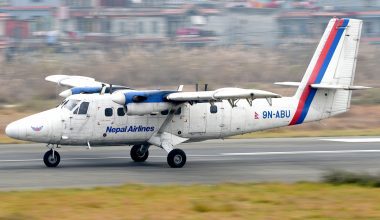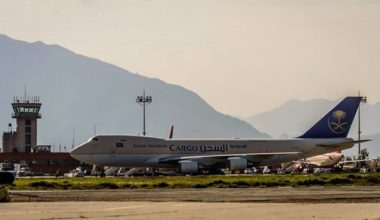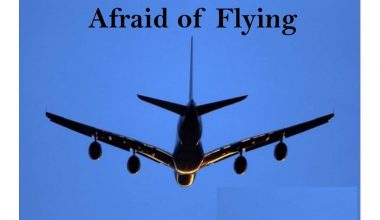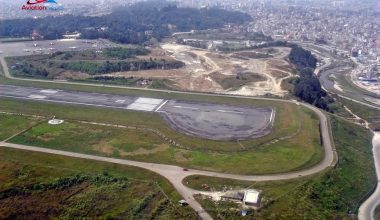Many of us have dreamt of becoming a pilot during our childhood. It’s a fascinating dream to take up to the skies and soar amongst the clouds.
If you still daydream of taking your career to a new height and becoming an airline pilot, you will need some truthful information to plan carefully in advance.
We have collected queries from many student pilots and answered them in this article. The answer has been provided by one of the Captain working currently in Airlines.
Also Read: Ten things to know about the pilot study from Nepal

1. Is pilot training a degree course?
License VS Degree
You must be already aware that pilot training is a license-based course and not a degree course. But you might be in a dilemma whether to pursue your dreams which is a license-only course or a degree course advised by your parents.
Also read: Bachelor of Aviation-All you need to know
Many students and parents argue that if they do a degree course but don’t get a job in the same area of study, their degree might be still be considered helpful in other areas. But if they do a licensing course and don’t get a job, their education becomes useless.

To get the idea, let’s consider a medical student who completed his MBBS and is now a medical doctor. Let’s say he doesn’t get a job in a hospital. Will his education be relevant in the hotel industry? In airlines? At an accounting firm? The answer is no.
Any degree in perspective of getting a job is relevant in that particular area only.
One important thing you need to understand is that every job has its requirements and required qualifications. To be able to fly an aircraft, a pilot’s license is required and not a degree. However, you can always top-up your academic qualification for your satisfaction and taste by studying some bachelor’s degree course part-time while doing the job as a pilot.
2) What are the requirements?
The minimum academic requirement to become a pilot as a Nepalese is to pass your +2 science (or equivalent) with physics and maths.
This is a requirement advised by the Ministry of Education and Civil Aviation Authority of Nepal.
If you don’t have +2 science but other qualifications such as +2 management, you will have to re-do your +2 science again.
3) Does Height matter? I wear glasses. Does it matter?
The main thing is that you should pass your class 1 medical. It is highly advisable to do your class 1 medical check-up with an aviation medical doctor before you go abroad for training.
Class 1 medical is the type and level of medical that is required to hold a Commercial Pilot’s License (CPL) and Airlines Transport Pilot’s License (ATPL)
Class 1 medical includes whole body check-ups. Including check-ups with optometric, physician, ENT doctor, blood, urine, psychological tests, and test to find any deformities on the body.
Wearing glasses is acceptable; there are many pilots worldwide who wear glasses. If you wear glasses, the only restriction placed on you is that you need to have one spare pair of glasses on your flight bag every time you fly.
There is no particular height restriction in place. Aircraft seats are adjustable so that even short pilots can reach controls. For your reference, we have met pilots as short as 5ft 1in (female) 5ft 3in (male).
4) Where to get training? I heard about ATO? What is CAAN-approved ATO?
You can get your training in any country or flight school registered with the Civil Aviation Authority of Nepal (CAAN). However, it is advisable to study in a country where the syllabus is broad. This is because, as a pilot, knowledge is paramount. As an airline pilot, you will use this knowledge for the rest of your life.
ATO or Approved Training Organisation is the training organization audited and inspected by CAAN officials and confirms that Nepalese students can enroll at such flight school for training purposes.
5) Why South Africa? Why not other countries?
South Africa follows EASA (European Union Aviation Safety Agency) syllabus for pilot training, which is considered the highest in pilot training.
But, no priority is given to one country’s pilot license because all countries follow the minimum required standard set by International Civil Aviation Authority (ICAO) and local aviation authorities such as CAAN.
6) Why south Africa is so cheap? Cheap training school can provide good training?
Many students from all over the African continent, Asia, and even Europe arrive in South Africa to do their pilot training. But why? And especially why if there are flight schools already in Europe, Asia, and America?
South Africa is highly developed in aviation. There are lots of world-class flight schools spread across the country. To give you an idea, there are a total of flight schools in the South. South Africans even manufacture general aviation and training aircraft on their soil.
Although there are flight schools available in Europe and Asian countries, the students still flock from those regions to South Africa because South Africa has many world-class flight schools. The cost of training is minimum because of competition.
Also, South Africa has excellent weather conditions for pilot training. You will be able to fly more in a year in South Africa than in other countries of Europe or the Americas. This will enable you to complete your training on time. Bad weather can cause training delays, and you can end up finishing your training way later than planned, and ultimately you may end up ending up in your pocket and your financial reserves.
South African Civil Aviation Authority (SACAA) is a strong governing body for aviation activities in South Africa. Because of this, the flight schools are audited and inspected at the highest level of standard so that the aircraft you fly are always in airworthy condition.
Cost and quality are the most significant factor while choosing any product. South Africa is the country that hosts the highest quality training for the most affordable rates. No wonder South Africa has been on the top of the list of student pilots over the years.
7) What is the cost to complete the training? And what is included in the training?
The cost varies from flight school and the type of aircraft they operate. The lowest rate that you can get is 46,000 USD; the package includes PPL, CPL, fATPL, ground classes, all exams, medical, insurance, local transportation, accommodation, flight training, simulator, study materials, and uniform.
8) What is Frozen ATPL?
ATPL stands for Airline Transport Pilot’s License. This is the type of license required to become an airline captain in most parts of the world. But in Nepal, frozen ATPL is the minimum requirement to work as a co-pilot/first officer in an airline.
For someone to obtain an ATPL, he/she must have a total of 1500 hours and must have passed all exams of ATPL subjects. However, if you give the ATPL subjects but are hours to reach the 1500 hours requirement, this condition in the pilot’s community is known as a frozen ATPL (fATPL). However, you should remember that there is no license issued such as fATPL, it just means that you have completed the theory exams of ATPL, but you are about 1300 hours short towards the required 1500 hours (1300 hours because by the time you write ATPL exams, you would have already accumulated about 200 hours from your CPL)
So, in short, fATPL means that you have completed CPL+ATPL exams. After completing your fATPL, you will have a period of five years to accumulate the remaining 1300 hours. Typically, pilots, after completing fATPL, begin looking for first officer positions in airlines and build the remaining 1300 hours on their job.
Frozen ATPL was introduced in Nepal by CAAN on the recommendation of EASA after frequent air crashes. This was introduced so that the first officer would also have a similar level of theoretical knowledge as the captain.
This is especially helpful in terms of Crew Resource Management and Human Factors. It helps minimize the cockpit gradient by equipping new and inexperienced first officers with the required knowledge. This allows creating harmony in the cockpit as a knowledgeable first officer is the captain’s best companion.
9) I heard CPL is not sufficient? Do I need to get the type rating too?
Yes, you heard it right. Like an MBBS doctor needs to do a specialization course to perform surgery on his patients; similarly, a new pilot with CPL and fATPL also needs to do type rating on a particular type of aircraft that the airline requires him to fly.
When you do your initial pilot training, you will fly training aircraft, which are relatively simple than those you will fly in an airline. The training course is required to get familiar with the new aircraft you will pass and its systems. Modern airliners and even commuter aircraft have advanced equipment such as Ground Proximity Warning System (GPWS), Traffic Collision Avoidance System (TCAS), Fire Extinguishing Systems, Auxiliary Power Unit (APU), Flight Management System (FMS), and automation. Since initial pilot training doesn’t cover these areas of knowledge, you will be taught in the area mentioned above during your type rating.
In this course, you will not be taught the basics of flying as you would have already done during your initial training. A type rating is more focused on learning the aircraft’s specifications and equipment. Type rating course usually lasts 30-45 days and is done at the manufacturers or a training center approved by CAAN and your airline.
Depending on the type of aircraft, the type rating can cost anywhere from 10 lakh to 25 lakh in Nepalese rupees. However, it’s up to the airlines to give you a quotation for the type rating.
10) What is type rating? What will be the cost?
Covered in q no. 9
12) Does the CPL license expire too? How can we renew it?
All licenses have an expiry date, and nothing lives forever. A pilot license is not a stand-alone document that a pilot needs to maintain during his career. A pilot also needs to keep his/her logbook, flight recency, recurrent training, etc.
There are various types of documents within a pilot’s license, such as a medical certificate and competency card, that reflect recurrent training provided by the airlines. The last date you took the training and expiry of the movement. Not maintaining one of the documents might cause you to temporarily lose your privilege of acting as a pilot unless you can refurbish those required documents again.
Many people who want to become a pilot doubt that if after completing their training they can’t find the job for several years, their license will be lost forever, and all their money, time, and dedication will be in vain. However, this is not true. If you haven’t flown for several years, you can still renew your license by fulfilling the CAAN requirement.
For example, a class 1 medical license expires in one year, and flying recency is lost if you cannot do three take off and landings within the last ninety days. This doesn’t mean that if you don’t find a job within ninety days from your previous flight or one year from your last medical, your license will be lost. Don’t be afraid; these requirements will be completed during your type rating course and base training once you join the airlines.
13) I heard I need to get the license to be converted from CAAN?
Yes, you need to get a CAAN license to act as a first officer in an airline in Nepal. After completing your CPL with fATPL abroad, you need to pass the CAAN Basic CPL exam, CAALOP (Air law and operating procedure course of CAAN), type rating course, and base training to be able to get a hard copy pilot’s license.
14) What is the procedure to convert the license to CAAN? What will be the fees?
It’s the same as q no 13; let’s not mention the fees as it might change.
15) What is the current market scenario for Jobs?
The current market scenario for any job in any sector doesn’t look good because of the COVID-19 pandemic. However, after the pandemic comes to a halt and people begin traveling for recreation and business, we can expect a boom in air travel and jobs for pilots.
Keeping the pandemic aside, there was a gradual increment in job opportunities for pilots. Considering the government’s plan for upgrading and construction of aviation infrastructure, we can assume that jobs for pilots will rise in the post-COVID-19 scenario.
16) How much will I earn on my first job as a pilot?
A new first officer usually makes about 80,000 NPR (basic salary+allowance including) initially. The salary increases almost every year with increments in-flight hours and seniority.
17) How to apply? from where can I apply? who will guide my process?
There are many consultancies in Nepal, but the one specializing in pilot training consultation and one of the best is AviationNepal Pilot Team.
AviationNepal connects you with a group of pilots from different airlines in Nepal and provides you with the ground classes required for Pilot Training in Nepal. We also help you with visa processing and transfer you to a world-class flight school abroad.
Please fill out the form below; our pilot will get back to you as soon as possible.

18) How many pilots are there in Nepal?
There are currently about 500 active pilots in Nepal (Please check CAAN data)
19) Nepali Pilots can fly international Airlines? I want to fly Boeing/Airbus, can I fly that too?
Yes, any pilot who has a type rating on a Boeing or an Airbus can fly it. But most of the time, pilots don’t choose which aircraft they will fly for their first job as the main priority after completing the training is finding a job and not choosing which aircraft make you fly.

But as you accumulate hours and experience, you can be upgraded to larger aircraft in your airlines. If your airlines don’t fly internationally, you can join a different airline once you accumulate the required experience.
20) How often pilots fly in a week, month, and year?
As a pilot, we can only fly up to 1000 hours in a year. This regulation is in place so that a pilot has balanced work and rest.






